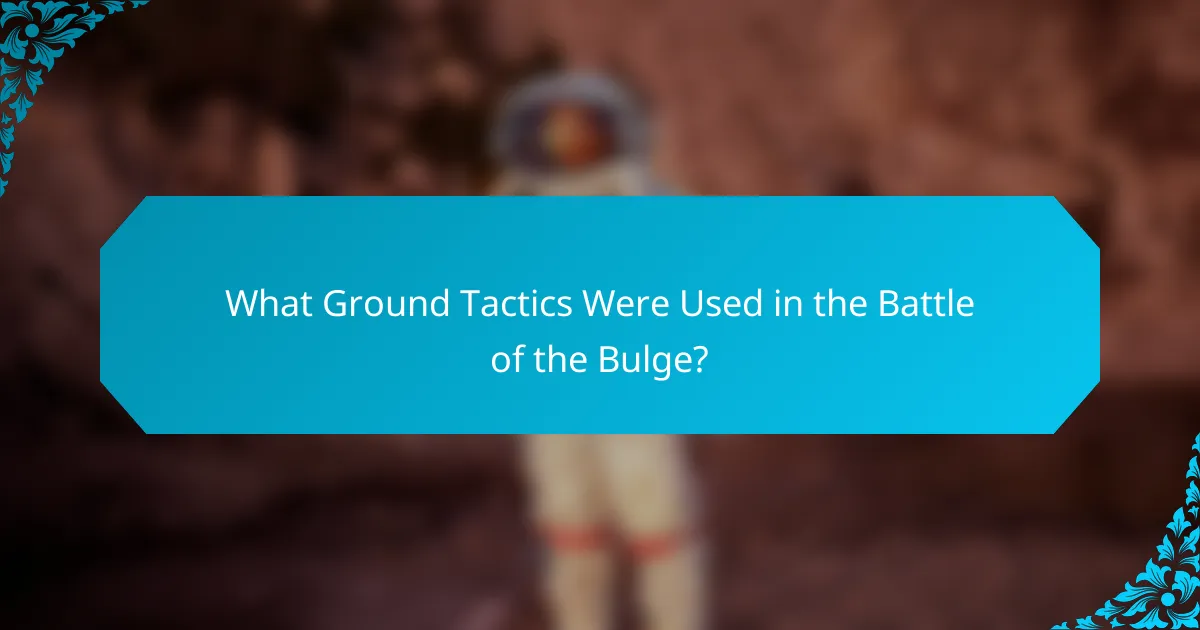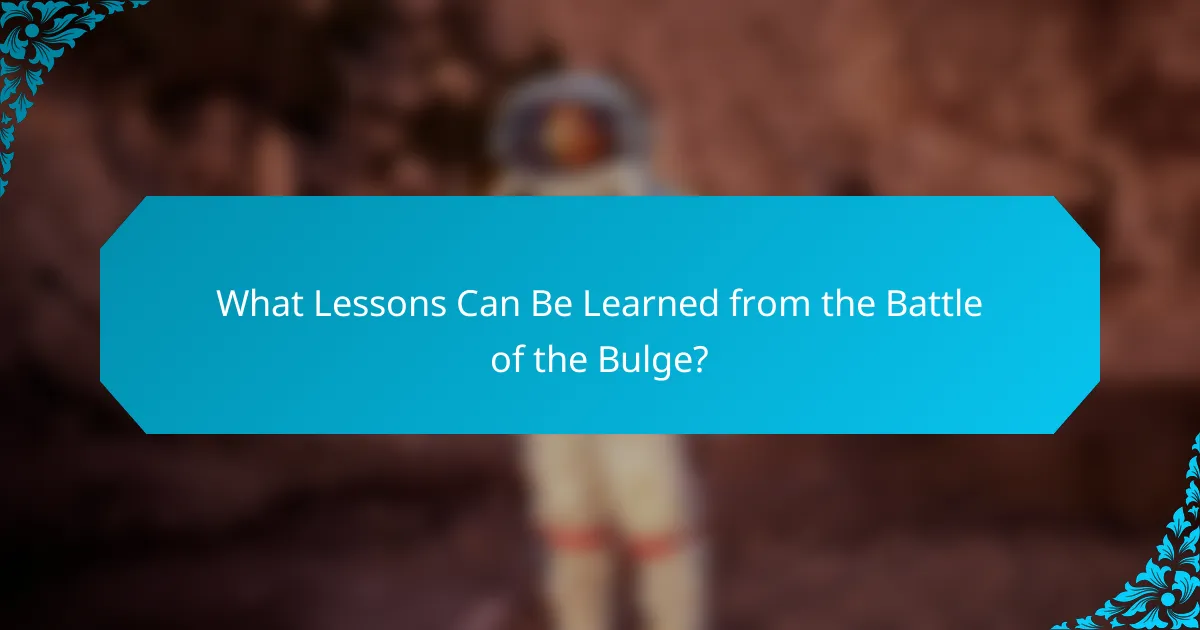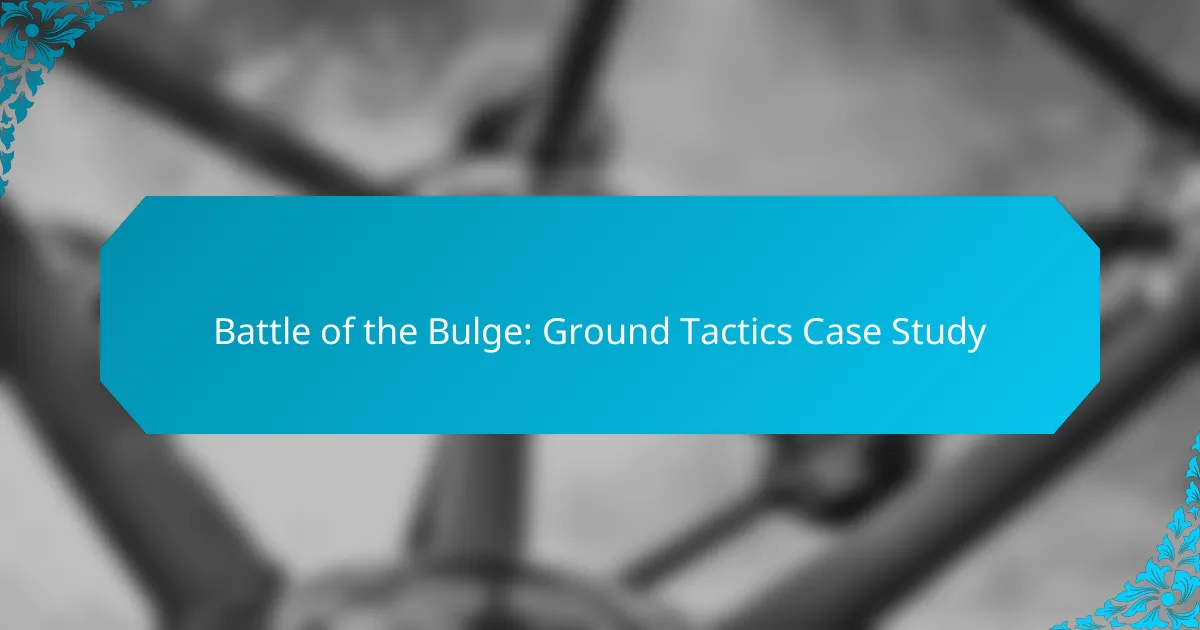The Battle of the Bulge showcased a variety of ground tactics that were essential for both the Allies and the Germans. The challenging terrain of the Ardennes, characterized by dense forests and rugged hills, significantly influenced military strategies and engagements. Key tactical decisions, including defensive strategies and rapid counteroffensives, played a crucial role in shaping the outcome of this pivotal conflict during the harsh winter of late 1944.

What Ground Tactics Were Used in the Battle of the Bulge?
The Battle of the Bulge involved a range of ground tactics that were crucial for both the Allies and the Germans. These tactics included defensive strategies, offensive maneuvers, and adaptations to the challenging terrain and weather conditions.
Defensive strategies by the Allies
The Allies employed a combination of static and mobile defensive strategies during the Battle of the Bulge. Key positions were fortified, particularly around the town of Bastogne, which became a critical stronghold. Troops were organized into units capable of rapid response to German advances, allowing for effective counterattacks.
Additionally, the Allies utilized a layered defense, where frontline units were supported by reserves positioned further back. This approach enabled them to absorb initial assaults while maintaining the ability to launch counteroffensives when opportunities arose.
Offensive maneuvers by the Germans
The Germans executed a surprise offensive that aimed to split the Allied forces and capture vital supply routes. Their tactics included rapid armored thrusts, known as blitzkrieg, which relied on speed and coordination between infantry and mechanized units. This approach allowed them to exploit weaknesses in the Allied lines.
German forces also utilized deception tactics, such as feints and misinformation, to mislead Allied command about their true intentions. This created confusion and delayed Allied responses, giving the Germans a temporary advantage in the early stages of the battle.
Terrain advantages
The rugged terrain of the Ardennes Forest provided both advantages and challenges for the combatants. The dense woods and hills allowed for concealment of troop movements, which the Germans exploited to launch surprise attacks. However, the difficult landscape also hindered mobility, particularly for armored units.
Allied forces adapted by using the terrain to their advantage, establishing defensive positions on high ground and utilizing natural barriers to slow down German advances. This strategic use of terrain was critical in mitigating the impact of the German offensive.
Use of weather conditions
The weather during the Battle of the Bulge played a significant role in shaping ground tactics. Initial heavy snowfall and overcast skies hampered visibility and mobility, favoring the German surprise attack. The Allies faced challenges in air support and resupply due to these adverse conditions.
As the weather cleared, Allied air power became a decisive factor, allowing for effective airstrikes against German positions and supply lines. This shift underscored the importance of weather in tactical planning and operational effectiveness during the battle.
Logistical challenges
Logistics were a critical aspect of ground tactics in the Battle of the Bulge, affecting both sides. The Germans faced significant supply issues, particularly with fuel and ammunition, which limited their ability to sustain their offensive. As their supply lines stretched, they became increasingly vulnerable to Allied counterattacks.
The Allies, while initially caught off guard, quickly adapted their logistics to reinforce key positions and maintain supply routes. Efficient use of rail and road networks, coupled with the establishment of supply depots, helped ensure that Allied forces remained well-equipped to respond to the German onslaught.

How Did Terrain Influence Tactics?
The terrain of the Ardennes region significantly shaped military tactics during the Battle of the Bulge. The dense forests, rugged hills, and challenging river crossings dictated movement, visibility, and engagement strategies for both Allied and Axis forces.
Impact of the Ardennes Forest
The Ardennes Forest presented a formidable barrier that affected visibility and maneuverability. Its dense trees and underbrush limited the effectiveness of armored units, forcing commanders to rely more on infantry and small unit tactics. This environment favored ambushes and surprise attacks, as units could conceal themselves effectively.
Allied forces had to adapt their strategies to counter the German advantage in the forest. They utilized reconnaissance and small patrols to gather intelligence and mitigate the risks posed by enemy ambushes. The forest’s terrain also influenced supply routes, necessitating careful planning to ensure adequate logistics support.
Role of the Schnee Eiffel
The Schnee Eiffel, a high ridge area, played a crucial role in the battle’s dynamics. Its elevation provided strategic vantage points for artillery and observation, allowing forces to control key approaches. The Germans exploited this terrain to establish strong defensive positions, complicating Allied advances.
Allied forces needed to consider the Schnee Eiffel’s impact on their tactics, often requiring flanking maneuvers or coordinated assaults to dislodge entrenched enemy units. The ridge’s weather conditions, including snow and fog, further complicated operations, affecting visibility and mobility for both sides.
Effect of river crossings
River crossings in the Ardennes were critical tactical points that influenced the pace and success of military operations. Major rivers like the Meuse and Semois posed significant obstacles, requiring careful planning and execution to ensure successful crossings. Control of these waterways could dictate the flow of reinforcements and supplies.
Forces had to prioritize securing bridges and establishing pontoon crossings, often under enemy fire. The timing and coordination of these operations were vital, as delays could lead to catastrophic losses. Commanders needed to assess the risks of crossing points and prepare for potential counterattacks during these vulnerable maneuvers.

What Were the Key Tactical Decisions?
The key tactical decisions during the Battle of the Bulge involved strategic planning, rapid counteroffensives, and command decisions that shaped the outcome of the conflict. These choices were critical in determining the effectiveness of both Allied and German forces in the harsh winter conditions of late 1944.
General Eisenhower’s strategy
General Eisenhower’s strategy focused on maintaining a strong defensive line while preparing for a counteroffensive. He recognized the importance of logistics and troop morale, ensuring that supply lines were secure and reinforcements were available when needed. Eisenhower’s ability to coordinate multiple Allied forces was crucial in responding to the German surprise attack.
One of his significant decisions was to allow General Patton to lead a rapid counteroffensive to relieve besieged troops in Bastogne. This move demonstrated Eisenhower’s trust in Patton’s capabilities and highlighted the importance of decisive leadership in critical moments.
General Patton’s counteroffensive
General Patton’s counteroffensive was marked by swift and aggressive maneuvers aimed at breaking the German advance. He ordered his Third Army to pivot northward to relieve Bastogne, a key town surrounded by German forces. This maneuver not only lifted the siege but also disrupted German supply lines and morale.
Patton’s forces utilized armored divisions effectively, leveraging their speed and firepower to counterattack. His ability to adapt to changing battlefield conditions allowed the Allies to regain the initiative, showcasing the importance of flexibility in military tactics.
German command decisions
The German command decisions during the Battle of the Bulge were characterized by a bold but risky strategy aimed at splitting the Allied forces. Adolf Hitler’s insistence on a surprise attack through the Ardennes Forest relied on the element of surprise and the hope of capturing Antwerp.
However, the German command underestimated the resilience of Allied forces and the harsh winter conditions. Poor communication and logistical challenges hampered their ability to sustain the offensive, ultimately leading to a failure to achieve their strategic objectives. This highlights the critical nature of effective command and control in military operations.

What Were the Outcomes of These Tactics?
The outcomes of the tactics used during the Battle of the Bulge were significant, leading to considerable casualties, territorial changes, and long-term strategic shifts in the European theater of World War II. These tactics, primarily employed by German forces, aimed to exploit weaknesses in Allied lines but ultimately resulted in a costly stalemate.
Casualty figures
Casualty figures from the Battle of the Bulge were substantial, with estimates suggesting that both sides incurred losses in the range of 185,000 to 200,000 personnel. The Allies faced around 75,000 casualties, while German losses were estimated to be higher, reflecting the intense fighting and harsh winter conditions.
These figures highlight the brutal nature of the conflict, where both sides suffered heavily due to combat, weather, and logistical challenges. The high casualty rates underscored the desperation of the German offensive and the resilience of Allied forces.
Territorial gains and losses
Initially, the German forces achieved significant territorial gains, capturing key towns like Bastogne and pushing deep into Allied-held territory. However, these gains were short-lived as Allied forces regrouped and launched counteroffensives, ultimately reclaiming lost ground.
By the end of the battle, the Allies had regained most of the territory lost during the initial German assault, but the conflict left the front lines largely unchanged. The temporary territorial shifts demonstrated the tactical prowess of both sides, yet the overall strategic situation remained largely intact.
Long-term strategic implications
The long-term strategic implications of the Battle of the Bulge were profound, marking a turning point in the war. The failure of the German offensive depleted their resources and morale, significantly weakening their ability to sustain further operations on the Western Front.
In contrast, the successful defense by Allied forces bolstered their confidence and solidified their commitment to push into Germany. The battle also highlighted the importance of logistics and intelligence in modern warfare, lessons that would influence future military strategies in the conflict.

What Lessons Can Be Learned from the Battle of the Bulge?
The Battle of the Bulge offers critical insights into military strategy, logistics, and the importance of intelligence. Key takeaways include the necessity of adaptability in tactics, the value of supply lines, and the impact of weather on operations.
Adaptability in Tactics
Flexibility in military tactics was crucial during the Battle of the Bulge. As the German forces launched a surprise offensive, Allied commanders had to quickly adjust their strategies to counter the unexpected attack. This highlights the importance of being prepared for rapid changes in the battlefield environment.
For modern military operations, this means developing contingency plans and training troops to respond effectively to unforeseen circumstances. Practicing scenario-based drills can enhance adaptability and readiness.
Importance of Supply Lines
The Battle underscored the critical role of supply lines in sustaining military operations. As German forces advanced, they faced logistical challenges that hindered their ability to maintain momentum. Conversely, the Allies’ ability to reinforce and resupply their troops was vital to their eventual success.
In contemporary contexts, ensuring robust supply chains and logistics support is essential. Military planners should prioritize securing supply routes and stockpiling necessary resources to avoid vulnerabilities during operations.
Impact of Weather on Operations
Weather played a significant role in the Battle of the Bulge, affecting visibility and troop movements. The harsh winter conditions initially favored the German offensive, but as the weather improved, Allied air support became a game-changer. This illustrates how environmental factors can influence tactical decisions.
Modern military forces must consider weather forecasts and seasonal patterns when planning operations. Utilizing advanced meteorological tools can aid in making informed decisions that enhance operational effectiveness.



